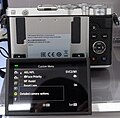 | |
| Overview | |
|---|---|
| Maker | OM Digital Solutions |
| Type | Mirrorless Interchangeable Lens Camera |
| Released | June 25, 2021 |
| Lens | |
| Lens mount | Micro Four Thirds |
| Sensor/medium | |
| Sensor type | Live MOS |
| Sensor size | 17.3 x 13mm (Four Thirds type) |
| Sensor maker | Sony |
| Maximum resolution | 20.3 megapixels 5184*3888 |
| Film speed | 100-25600 |
| Recording medium | SD, SDHC or SDXC memory card |
| Focusing | |
| Focus areas | 121 focus points |
| Flash | |
| Flash | pop-up internal |
| Shutter | |
| Shutter speeds | 1/4000 to 60s (mechanical) 1/16000s to 60s (electronic) |
| Continuous shooting | 8.7fps (mechanical) 15fps (electronic) |
| Image processing | |
| Image processor | TruePic VIII |
| White balance | Yes |
| General | |
| Video recording | 4K: 3840×2160, 30/25/24p, ~102 Mbps FHD: 1920×1080, 60/50/30/25/24p HD: 1280×720 |
| LCD screen | 3 inches with 1,037,000 dots tilt, touchcscreen |
| Battery | BLS-50 |
| Data port(s) | USB Type-B (USB2.0) Micro HDMI (type D) WiFi 802.11a/b/g/n/ac |
| Body features | 5-axis in-body image stabilization |
| Dimensions | 118.3×68.5×38.1 mm (4.66×2.70×1.50 in) |
| Weight | 289 g (10 oz) (body only) 337g (including battery and memory card) |
| Made in | Vietnam |
The Olympus PEN E-P7 is a mirrorless interchangeable-lens camera launched on 25 June 2021 by OM Digital Solutions under the Olympus brand. OM Digital Solutions became independent from Olympus Corporation on 9 October 2020 and took over the OM-D, PEN and ZUIKO brands. It is the first new model to be launched by OM Digital Solutions since its independence, with a retro-style design that echoes the design of the PEN-F launched in 2016, with aluminium dials and a pop-up flash. Though released recently, the E-P7 does not feature a USB Type-C port, but a Micro USB Type-B port as seen in previous generations. [1] [2]




